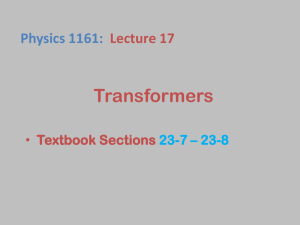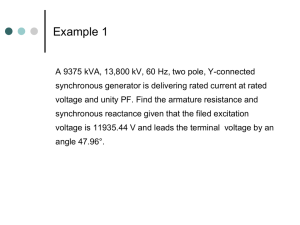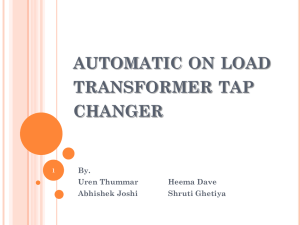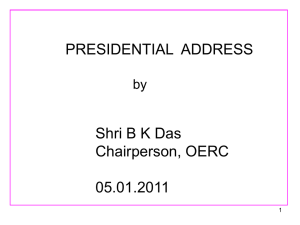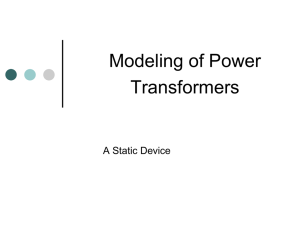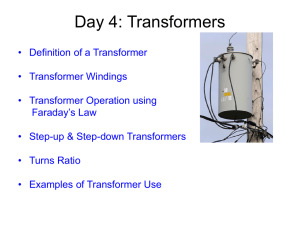Chapter 21
advertisement
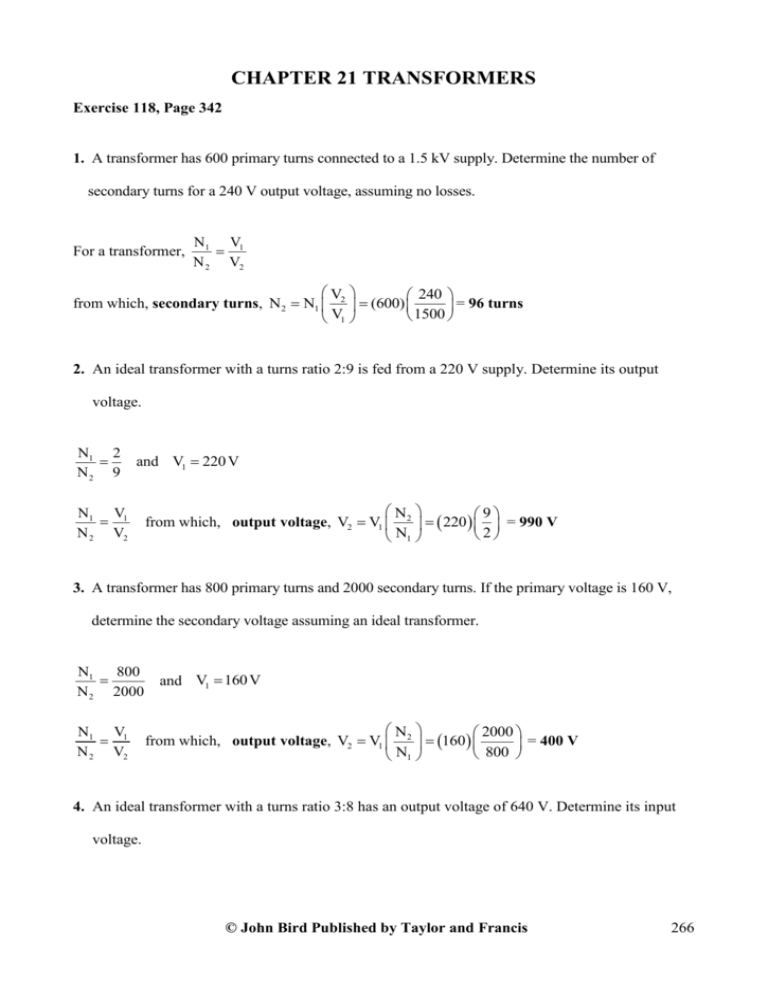
CHAPTER 21 TRANSFORMERS Exercise 118, Page 342 1. A transformer has 600 primary turns connected to a 1.5 kV supply. Determine the number of secondary turns for a 240 V output voltage, assuming no losses. For a transformer, N1 V1 N 2 V2 V 240 from which, secondary turns, N 2 N1 2 (600) = 96 turns 1500 V1 2. An ideal transformer with a turns ratio 2:9 is fed from a 220 V supply. Determine its output voltage. N1 2 N2 9 and V1 220 V N1 V1 N 2 V2 N 9 from which, output voltage, V2 V1 2 220 = 990 V 2 N1 3. A transformer has 800 primary turns and 2000 secondary turns. If the primary voltage is 160 V, determine the secondary voltage assuming an ideal transformer. N1 800 N 2 2000 N1 V1 N 2 V2 and V1 160 V N 2000 from which, output voltage, V2 V1 2 160 = 400 V N 800 1 4. An ideal transformer with a turns ratio 3:8 has an output voltage of 640 V. Determine its input voltage. © John Bird Published by Taylor and Francis 266 N1 3 and V2 640 V N2 8 N1 V1 N 2 V2 N 3 from which, input voltage, V1 V2 1 640 = 240 V 8 N2 5. An ideal transformer has a turns ratio of 12:1 and is supplied at 192 V. Calculate the secondary voltage. N1 12 N2 1 and V1 192 V N1 V1 N 2 V2 N 1 from which, output voltage, V2 V1 2 192 = 16 V 12 N1 6. A transformer primary winding connected across a 415 V supply has 750 turns. Determine how many turns must be wound on the secondary side if an output of 1.66 kV is required. N1 V1 N 2 V2 V 1660 from which, secondary turns, N2 N1 2 750 = 3000 turns 415 V1 7. An ideal transformer has a turns ratio of 15:1 and is supplied at 180 V when the primary current is 4 A. Calculate the secondary voltage and current. N1 12 , V1 220 V and I1 4 A N2 1 N1 V1 N 2 V2 N 1 from which, output voltage, V2 V1 2 180 = 12 V 15 N1 N1 I 2 N 2 I1 N 15 from which, secondary current, I2 I1 1 4 = 60 A 1 N2 8. A step-down transformer having a turns ratio of 20:1 has a primary voltage of 4 kV and a load of 10 kW. Neglecting losses, calculate the value of the secondary current. © John Bird Published by Taylor and Francis 267 N1 20 N2 1 and V1 4000 V N1 V1 N 2 V2 N 1 from which, output voltage, V2 V1 2 4000 = 200 V 20 N1 Secondary power = V2 I 2 = 10000 i.e. 200 I 2 = 10000 secondary current, I 2 from which, 10000 = 50 A 200 9. A transformer has a primary to secondary turns ratio of 1:15. Calculate the primary voltage necessary to supply a 240 V load. If the load current is 3 A determine the primary current. Neglect any losses. N1 V1 I 2 N 2 V2 I1 If V 1 1 15 240 If 1 3 15 I1 i.e. V 1 3 1 15 240 I1 1 then primary voltage, V1 240 = 16 V 15 15 then primary current, I1 3 = 45 A 1 10. A 10 kVA, single-phase transformer has a turns ratio of 12:1 and is supplied from a 2.4 kV supply. Neglecting losses, determine (a) the full load secondary current, (b) the minimum value of load resistance which can be connected across the secondary winding without the kVA rating being exceeded, and (c) the primary current. 10000 = V1 I1 V2 I2 , (a) N1 V1 N 2 V2 N1 12 and V1 2400 V N2 1 N 1 from which, output voltage, V2 V1 2 2400 = 200 V 12 N1 10000 VA = V2 I 2 = 200 I 2 from which, secondary current, I 2 10000 = 50 A 200 © John Bird Published by Taylor and Francis 268 (b) Load resistance, R L (c) V2 200 =4 I2 50 N 1 from which, primary current, I1 I2 2 50 = 4.17 A 12 N1 N1 I 2 N 2 I1 11. A 20 resistance is connected across the secondary winding of a single-phase power transformer whose secondary voltage is 150 V. Calculate the primary voltage and the turns ratio if the supply current is 5 A, neglecting losses. Secondary current, I 2 N1 V1 N 2 V2 V2 150 = 7.5 A , I1 5A and R 2 20 V2 = 150 V N I 7.5 from which, primary voltage, V1 V2 1 V2 2 150 = 225 V 5 N2 I1 Turns ratio, 3 N1 I 2 7.5 = 1.5 or 2 N 2 I1 5 or 3:2 © John Bird Published by Taylor and Francis 269 Exercise 119, Page 344 1. A 500 V/100 V, single-phase transformer takes a full load primary current of 4 A. Neglecting losses, determine (a) the full load secondary current, and (b) the rating of the transformer. (a) V V1 I 2 500 from which, full load secondary current, I2 I1 1 (4) = 20 A V2 I1 100 V2 (b) Transformer rating = V1 I1 500 4 = 2000 VA = 2 kVA or transformer rating = V2 I2 100 20 = 2000 VA = 2 kVA 2. A 3300 V/440 V, single-phase transformer takes a no-load current of 0.8 A and the iron loss is 500 W. Draw the no-load phasor diagram and determine the values of the magnetizing and core loss components of the no-load current. V1 3300 V , V2 440 V and IO 0.8A Core or iron loss = 500 = V1 IO cos O from which, cos O i.e. 500 = 0.1894 3300 0.8 500 = 3300 0.8 cos O and O cos 1 0.1894 79.08 The no-load phasor diagram is shown below. Magnetizing component, IM IO sin O 0.8sin 79.08 = 0.786 A Core loss component, IC IO cos O 0.8(0.1894) = 0.152 A © John Bird Published by Taylor and Francis 270 3. A transformer takes a current of 1 A when its primary is connected to a 300 V, 50 Hz supply, the secondary being on open-circuit. If the power absorbed is 120 watts, calculate (a) the iron loss current, (b) the power factor on no-load, and (c) the magnetizing current. IO 1A and V1 300 V (a) Power absorbed = total core loss = 120 = V1 IO cos O i.e. and 120 = (300) IO cos O iron loss current, IC IO cos O = (b) Power factor on no-load, cos O 120 = 0.40 A 300 IC 0.4 = 0.40 IO 1 (c) By Pythagoras, IO 2 IC 2 I M 2 from which, magnetizing current, IM IO 2 IC2 12 0.402 = 0.917 A © John Bird Published by Taylor and Francis 271 Exercise 120, Page 346 1. A 60 kVA, 1600 V/100 V, 50 Hz, single-phase transformer has 50 secondary windings. Calculate (a) the primary and secondary current, (b) the number of primary turns and (c) the maximum value of the flux. V1 1600 V , V2 100 V , f = 50 Hz, N 2 50 turns (a) Transformer rating = V1 I1 V2 I2 60000 VA hence, and (b) V1 N1 V2 N 2 primary current, I1 60000 60000 = 37.5 A V1 1600 secondary current, I 2 60000 60000 = 600 A V2 100 V 1600 from which, primary turns, N1 1 N 2 50 = 800 turns 100 V2 (c) E2 4.44f M N2 from which, maximum flux, M E2 100 = 9.0 mWb 4.44f N 2 4.44 50 50 2. A single-phase, 50 Hz transformer has 40 primary turns and 520 secondary turns. The crosssectional area of the core is 270 cm2. When the primary winding is connected to a 300 volt supply, determine (a) the maximum value of flux density in the core, and (b) the voltage induced in the secondary winding (a) From equation (4), e.m.f. E1 = 4.44 f m N1 volts i.e. 300 = 4.44 (50) m (40) from which, maximum flux density, m = 300 Wb = 0.033784 Wb (4.44)(50)(40) However, m = Bm A, where Bm = maximum flux density in the core and A = cross-sectional area of the core © John Bird Published by Taylor and Francis 272 (see chapter 7) Bm 270 10 -4 Hence, = 0.033784 from which, maximum flux density, Bm = (b) 0.033784 = 1.25 T 270 10 4 N V1 N = 1 from which, V2 = V1 2 V2 N2 N1 520 i.e. voltage induced in the secondary winding, V2 = (300) = 3900 V or 3.90 kV 40 3. A single-phase 800 V/100 V, 50 Hz transformer has a maximum core flux density of 1.294 T and an effective cross-sectional area of 60 cm 2 . Calculate the number of turns on the primary and secondary windings. Since B A then M BM A 1.294 60 104 = 7.764 mWb E1 4.44f M N1 from which, primary turns, N1 E1 800 4.44 f M 4.44 50 7.764 10 3 = 464 turns E2 4.44f M N2 from which, secondary turns, N 2 E2 100 4.44 f M 4.44 50 7.764 103 = 58 turns 4. A 3.3 kV/110 V, 50 Hz, single-phase transformer is to have an approximate e.m.f. per turn of 22 V and operate with a maximum flux of 1.25 T. Calculate (a) the number of primary and secondary turns, and (b) the cross-sectional area of the core E1 E = 2 = 22 N1 N2 E 3300 Hence primary turns, N1 = 1 = = 150 22 22 (a) E.m.f. per turn = and secondary turns, N2 = E 2 110 = =5 22 22 © John Bird Published by Taylor and Francis 273 (b) E.m.f. E1 = 4.44 f m N1 from which, m = 3300 E1 = = 0.0991 Wb 4.44f N 1 (4.44)(50)(150) Now flux, m = Bm A, where A is the cross-sectional area of the core, hence area, A = 0.0991 m = = 0.07928 m 2 or 792.8 cm 2 1.25 Bm © John Bird Published by Taylor and Francis 274 Exercise 121, Page 347 1. A single-phase transformer has 2400 turns on the primary and 600 turns on the secondary. Its noload current is 4 A at a power factor of 0.25 lagging. Assuming the volt drop in the windings is negligible, calculate the primary current and power factor when the secondary current is 80 A at a power factor of 0.8 lagging. Let I1 ' be the component of the primary current which provides the restoring m.m.f. I1 ' N1 I2 N 2 Then i.e. I1 '(2400) (80)(600) from which, I1 ' 80 600 2400 = 20 A If the power factor of the secondary is 0.8, then cos 2 0.8 from which, 2 cos 1 0.8 36.87 If the power factor at no load is 0.25, then cos O 0.25 from which, O cos 1 0.25 75.52 In the phasor diagram shown below, I 2 = 80 A at an angle 2 36.87 to V2 and I1 ' 20 A and is shown anti-phase to I 2 © John Bird Published by Taylor and Francis 275 The no load current, IO = 4 A is shown at an angle O 75.52 to V1 Current I1 is the phasor sum of I1 ' and IO and by calculation: Total horizontal component, I1 cos 1 IO cos O I1 'cos 2 = (4)(0.25) + (20)(0.8) = 1 + 16 = 17 A Total vertical component, I1 sin 1 IO sin O I1 'sin 2 = (4)(sin 75.52) + (20)(sin 36.87) = 15.87 A Hence, magnitude of I1 = 172 15.872 = 23.26 A and 15.87 1 15.87 tan 1 and 1 tan 43.03 17 17 Hence, power factor = cos O = cos 43.03 = 0.73 © John Bird Published by Taylor and Francis 276 Exercise 122, Page 350 1. A transformer has 1200 primary turns and 200 secondary turns. The primary and secondary resistances are 0.2 and 0.02 respectively and the corresponding leakage reactances are 1.2 and 0.05 respectively. Calculate (a) the equivalent resistance, reactance and impedance referred to the primary winding, and (b) the phase angle of the impedance. 2 V 1200 (a) Equivalent resistance, R e R1 R 2 1 0.2 0.02 = 0.92 200 V2 2 2 V 1200 Equivalent reactance, X e X1 X 2 1 1.2 0.05 = 3.0 200 V2 2 Equivalent impedance, Ze R e 2 Xe 2 0.922 3.02 = 3.138 or 3.14 (b) cos e Re 0.92 Ze 3.138 0.92 and phase angle of impedance, e cos 1 = 72.95 3.138 © John Bird Published by Taylor and Francis 277 Exercise 123, Page 350 1. A 6 kVA, 100 V/500 V, single-phase transformer has a secondary terminal voltage of 487.5 V when loaded. Determine the regulation of the transformer. Regulation = = no load sec ondary voltage ter min al voltage on l oad 100% no load sec ondary voltage 500 487.5 12.5 100% 100% = 2.5% 500 500 2. A transformer has an open circuit voltage of 110 volts. A tap-changing device operates when the regulation falls below 3%. Calculate the load voltage at which the tap-changer operates. Regulation = Hence, from which, and 3= no load sec ondary voltage ter min al voltage on l oad 100% no load sec ondary voltage 110 V2 100% 110 3(110) 110 V2 100 V2 110 3(110) = 106.7 V = voltage at which the tap-changer operates. 100 © John Bird Published by Taylor and Francis 278 Exercise 124, Page 352 1. A single-phase transformer has a voltage ratio of 6:1 and the h.v. winding is supplied at 540 V. The secondary winding provides a full load current of 30 A at a power factor of 0.8 lagging. Neglecting losses, find (a) the rating of the transformer, (b) the power supplied to the load, (c) the primary current. V1 6 and V1 540 V V2 1 hence, V2 540 = 90 V and I 2 = 30 A 6 (a) Rating of transformer = V2 I2 90 30 = 2700 VA or 2.7 kVA (b) Power supplied to load = V I cos = (2700)(0.8) since power factor = cos = 0.8 = 2.16 kW (c) V1 I 2 V2 I1 V 1 from which, primary current, I1 I2 2 30 = 5 A 6 V1 2. A single-phase transformer is rated at 40 kVA. The transformer has full-load copper losses of 800 W and iron losses of 500 W. Determine the transformer efficiency at full load and 0.8 power factor. Efficiency = output power input power losses losses 1 input power input power input power Full-load output power = V I cos = (40)(0.8) = 32 kW Total losses = 800 + 500 = 1.3 kW Input power = output power + losses = 32 + 1.3 = 33.3 kW Hence, efficiency, 1 1.3 = 0.961 or 96.10% 33.3 3. Determine the efficiency of the transformer in problem 2 at half full-load and 0.8 power factor. © John Bird Published by Taylor and Francis 279 Half full load power output = 1 40 0.8 = 16 kW 2 Copper loss (or I2 R loss) is proportional to current squared 2 1 Hence, copper loss at half full load = 800 = 200 W 2 Iron loss == 500 W (constant) Total loss = 200 + 500 = 700 W or 0.7 kW Input power at half full load = output power at half full load + losses = 16 + 0.7 = 16.7 kW Hence, efficiency, 1 losses 0.7 1 = 0.9581 or 95.81% input power 16.7 4. A 100 kVA, 2000 V/400 V, 50 Hz, single-phase transformer has an iron loss of 600 W and a fullload copper loss of 1600 W. Calculate its efficiency for a load of 60 kW at 0.8 power factor. Efficiency = output power input power losses losses 1 input power input power input power Full-load output power = V I cos = (100)(0.8) = 80 kW Load power = 60 kW Hence the transformer is at 60 3 full load 80 4 2 3 Hence, copper loss at 3/4 load = 1600 = 900 W 4 Total losses = 900 + 600 = 1.5 kW Input power = output power + losses = 60 + 1.5 = 61.5 kW Hence, efficiency, 1 1.5 = 0.9756 or 97.56% 61.5 © John Bird Published by Taylor and Francis 280 5. Determine the efficiency of a 15 kVA transformer for the following conditions: (i) full-load, unity power factor (ii) 0.8 full-load, unity power factor (iii) half full-load, 0.8 power factor. Assume that iron losses are 200 W and the full-load copper loss is 300 W (i) Full load power output = V I cos = (15)(1) = 15 kW Losses = 200 + 300 = 500 W or 0.5 kW Input power at full load = output power + losses = 15 + 0.5 = 15.5 kW Hence, efficiency, 1 losses 0.5 1 = 0.9677 or 96.77% input power 15.5 (ii) At 0.8 full load, unity power factor, output power = 0.8 15 = 12 kW Losses = 0.8 300 200 192 200 = 392 W or 0.392 kW 2 Input power at 0.8 full load = output power at 0.8 full load + losses = 12 + 0.392 = 12.392 kW Hence, efficiency, 1 0.392 = 0.9684 or 96.84% 12.392 (iii) At 0.5 full load and 0.8 power factor, output power = 0.5 15 0.8= 6 kW Losses = 0.5 300 200 75 200 = 275 W or 0.275 kW 2 Input power at 0.5 full load = output power at 0.5 full load + losses = 6 + 0.275 = 6.275 kW Hence, efficiency, 1 0.275 = 0.9562 or 95.62% 6.275 6. A 300 kVA transformer has a primary winding resistance of 0.4 and a secondary winding resistance of 0.0015 . The iron loss is 2 kW and the primary and secondary voltages are 4 kV and 200 V respectively. If the power factor of the load is 0.78, determine the efficiency of the transformer (a) on full load, and (b) on half load. © John Bird Published by Taylor and Francis 281 (a) Rating = 300 kVA = V1 I1 = V2 I2 Hence primary current, I1 = 400 10 3 300 10 3 = = 75 A V1 4000 and secondary current, I2 = 300 10 3 300 10 3 = = 1500 A V2 200 Total copper loss = I12 R1 + I22 R2, (where R1 = 0.4 and R2 = 0.0015 ) = (75)2(0.4) + (1500)2(0.0015) = 2250 + 3375 = 5625 watts On full load, total loss = copper loss + iron loss = 5625 + 2000 = 7625 W = 7.625 kW Total output power on full load = V2 I2 cos 2 = (300 103)(0.78) = 234 kW Input power = output power + losses = 234 kW + 7.625 kW = 241.625 kW losses Efficiency, = 1 100% input power 7.625 = 1 100% = 96.84% 241.625 (b) Since the copper loss varies as the square of the current, then total 2 1 copper loss on half load = 5625 = 1406.25 W 2 Hence total loss on half load = 1406.25 + 2000 = 3406.25 W or 3.40625 kW Output power on half full load = 1 (234) = 117 kW 2 Input power on half full load = output power + losses = 117 kW + 3.40625 kW = 120.40625 kW Hence efficiency at half full load, © John Bird Published by Taylor and Francis 282 losses = 1 100% input power 3.40625 = 1 100% = 97.17% 120.40625 7. A 250 kVA transformer has a full load copper loss of 3 kW and an iron loss of 2 kW. Calculate (a) the output kVA at which the efficiency of the transformer is a maximum, and (b) the maximum efficiency, assuming the power factor of the load is 0.80. (a) Let x be the fraction of full load kVA at which the efficiency is a maximum. The corresponding total copper loss = 3kW x 2 At maximum efficiency, copper loss = iron loss Hence, 3x 2 2 from which, x2 2 3 and x= 2 = 0.8165 3 Thus, the output kVA at maximum efficiency = 0.8165 250 = 204.1 kVA (b) Total loss at maximum efficiency = 2 2 = 4 kW Output power = 204.1 0.8 = 163.3 kW Input power = output power + losses = 163.3 + 4 = 167.3 kW Hence, maximum efficiency, 1 4 = 0.9761 or 97.61% 167.3 © John Bird Published by Taylor and Francis 283 Exercise 125, Page 355 1. A transformer having a turns ratio of 8:1 supplies a load of resistance 50 . Determine the equivalent input resistance of the transformer. 2 N 8 The equivalent input resistance, R1 = 1 R L = (50) = 3200 Ω = 3.2 k 1 N2 2 2. What ratio of transformer turns is required to make a load of resistance 30 appear to have a resistance of 270 2 N R1 1 R L N2 2 i.e. N 270 = 1 30 N2 2 from which, N1 270 9 30 N2 N1 9 3 N2 and i.e. the turns ratio required is 3:1 3. Determine the optimum value of load resistance for maximum power transfer if the load is connected to an amplifier of output resistance 147 through a transformer with a turns ratio of 7:2 The equivalent input resistance R1 of the transformer needs to be 147 for maximum power transfer. 2 N R1 = 1 R L from which, RL = R1 N2 2 N2 2 = 147 = 12 7 N1 2 4. A single-phase, 240 V/2880 V ideal transformer is supplied from a 240 V source through a cable of resistance 3 . If the load across the secondary winding is 720 determine (a) the primary current flowing and (b) the power dissipated in the load resistance. The circuit is as shown below. © John Bird Published by Taylor and Francis 284 N1 V1 240 1 N 2 V2 2880 12 (a) 2 N 1 Equivalent input resistance, R1 1 R L 720 = 5 12 N2 2 Total input resistance, R IN R R1 = 3 + 5 = 8 Hence, primary current, I1 N1 I 2 N 2 I1 (b) from which, V1 240 = 30 A R IN 8 N 1 I2 I1 1 30 = 2.5 A 12 N2 Power dissipated in load, P = I 2 2 R L 2.5 720 = 4500 W or 4.5 kW 2 5. A load of resistance 768 is to be matched to an amplifier which has an effective output resistance of 12 . Determine the turns ratio of the coupling transformer. 2 N R1 1 R L N2 and 2 N hence 12 = 1 768 N2 and 12 N1 768 N 2 2 N1 12 1 N2 768 8 Hence, the turns ratio of the coupling transformer is 1:8 6. An a.c. source of 20 V and internal resistance 20 k is matched to a load by a 16:1 single-phase transformer. Determine (a) the value of the load resistance and (b) the power dissipated in the load. © John Bird Published by Taylor and Francis 285 The circuit is shown below. (a) For maximum power transfer, R 1 needs to be 20 k 2 2 N N 1 R 1 1 R L from which, load resistance, R L R1 2 (20000) = 78.13 16 N2 N1 2 (b) Total input resistance when source is connected to the matching transformer is R IN R1 , i.e. 20 k + 20 k = 40 k Primary current, I1 N1 I 2 N 2 I1 V 20 = 0.5 mA 40000 40000 from which, N 16 I2 I1 1 0.5 103 = 8 mA 1 N2 Power dissipated in load, P = I2 2 R L 8 103 78.13 = 5 mW 2 © John Bird Published by Taylor and Francis 286 Exercise 126, Page 357 1. A single-phase auto transformer has a voltage ratio of 480 V:300V and supplies a load of 30 kVA at 300 V. Assuming an ideal transformer, calculate the current in each section of the winding. Rating = 30 kVA = V1 I1 V2 I2 Hence, primary current, I1 and 30 103 = 62.5 A 480 secondary current, I 2 30 103 = 100 A 300 Hence, current in common part of winding = I2 I1 = 100 – 62.5 = 37.5 A 2. Calculate the saving in the volume of copper used in an auto transformer compared with a double-wound transformer for (a) a 300 V:240 V transformer, and (b) a 400 V:100 V transformer. (a) For a 300 V:240 V transformer, x = V2 240 = 0.80 V1 300 From equation (20.12), volume of copper in auto transformer = (1 – 0.80)(volume of copper in a double-wound transformer) = (0.20)(volume of copper in a double-wound transformer) Hence, saving is 80% (b) For a 400 V:1000 V transformer, x = V2 100 = 0.25 V1 400 From equation (20.12), volume of copper in auto transformer = (1 – 0.25)(volume of copper in a double-wound transformer) = (0.75)(volume of copper in a double-wound transformer) Hence, saving is 25% © John Bird Published by Taylor and Francis 287 Exercise 127, Page 358 1. A three-phase transformer has 600 primary turns and 150 secondary turns. If the supply voltage is 1.5 kV determine the secondary line voltage on no-load when the windings are connected (a) delta-star, (b) star-delta. (a) For a delta connection, VL VP hence, primary phase voltage, VP1 = 1.5 kV = 1500 V N 150 Secondary phase voltage, VP2 = VP1 2 (1500) = 375 V 600 N1 For a star connection, VL 3 VP 3 375 = 649.5 V hence, secondary line voltage = (b) For a star connection, VL 3 VP or VP Primary phase voltage, VP1 VL1 3 VL 3 1500 = 866.0 V 3 For a delta connection, VL VP N1 V1 N 2 V2 N 150 from which, secondary phase voltage, VP2 VP1 2 (866.0) 600 N1 = 216.5 V = secondary line voltage © John Bird Published by Taylor and Francis 288 Exercise 128, Page 353 1. A current transformer has two turns on the primary winding and a secondary winding of 260 turns. The secondary winding is connected to an ammeter with a resistance of 0.2 , the resistance of the secondary winding is 0.3 . If the current in the primary winding is 650 A, determine (a) the reading on the ammeter, (b) the potential difference across the ammeter, and (c) the total load in VA on the secondary. N 2 (a) Reading on ammeter, I2 I1 1 (650) =5A 260 N2 (b) P.d. across ammeter = I2 R 2 (5)(0.2) = 1 V (c) Total resistance of secondary circuit = 0.2 + 0.3 = 0.5 Induce e.m.f. in secondary = (5)(0.5) = 2.5 V Total load on secondary = (2.5)(5) = 7.5 VA © John Bird Published by Taylor and Francis 289
